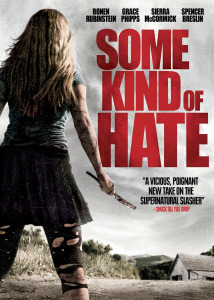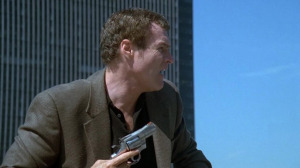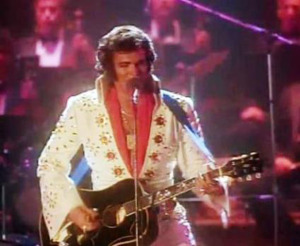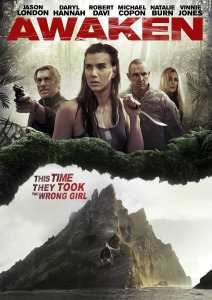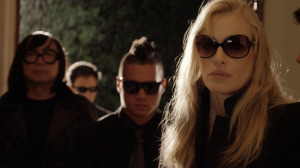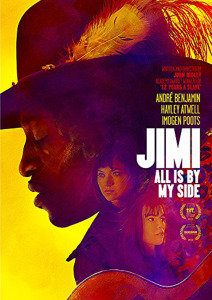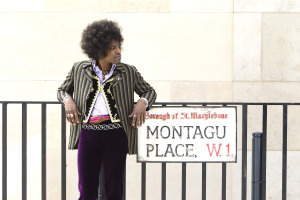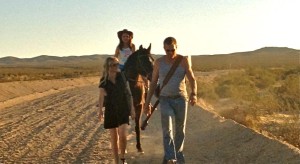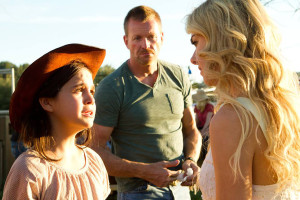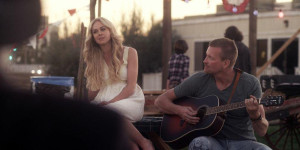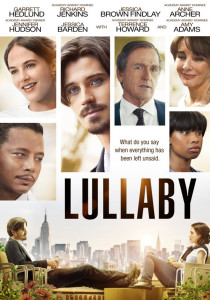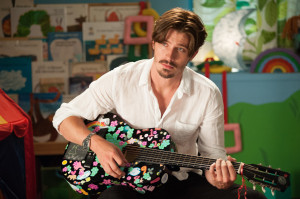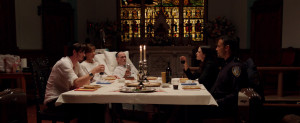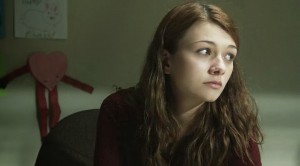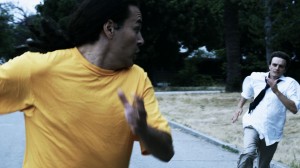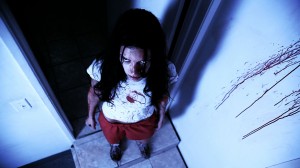(IMAGE ENTERTAINMENT/CALIBER MEDIA/DESTROY ALL ENTERTAINMENT/REVEK ENTERTAINMENT (83 minutes; Unrated); 2015)
Today’s version of the slasher movie is very rarely a nuanced thing; these flicks are more about the body count, finding unique ways to raise that body count, as well as making sure that a fair number of the bodies being counted are either scantily clad or completely unclad… there is generally no rhyme or reason for the slaughter, as the slasher (rather human, spirit, demon or other) just shows up and starts hacking. I’m not going to tell you that certain aspects of the genre are not here in spades with SOME KIND OF HATE but, the reasons are well-placed and well-thought-out. The writers‘ (Brian DeLeeuw and Adam Egypt Mortimer co-wrote the screenplay) original concept and script was titled BULLIED, so there is much more of a message here than the usual “let’s go to the woods, get drunk and screw” mentality of one of these things. Obviously, bullying is a horrible problem pervading our society, particularly our school systems. It isn’t a new thing… there have always been older, bigger, richer, prettier, whatever type of people who feel a need to push and belittle those they deem to be beneath them; sometimes a bully is someone who is so insecure that they attack others just to feel good about themselves. The problem – and the symptoms – seems to be getting worse, with the number of victims rising daily. Even without the vengeful spirit aspect of this movie, the under-riding theme is enough of a horror story on its own merits. This ain’t no AFTERSCHOOL SPECIAL or one of those “Very Special Episodes,” though… there’s too much blood.

The lead character, Lincoln, is your standard issue dark and brooding angst-ridden type… a quiet, artistic tortured soul who is abused at home and bullied at school (played to the quiet, brooding hilt by Ronen Rubenstein, who explained in a recent interview that, while he was never really bullied, one of his friends was bullied to the point that he committed suicide). Lincoln tries to stay out of the way of the big-man-on-campus, spoiled jock who delights in torturing those he deems too different (Lincoln is an “art fag” who doesn’t look or dress like everybody else); the loutish tormentor – his friends and hangers-on trailing behind like puppies – finds Lincoln alone and pushes the kid over the edge. Of course, when Lincoln retaliates, he is the one deemed a troublemaker and he is the one sentenced to a rehabilitation facility for teens with anti-social proclivities. The secluded “camp” is one of those “let’s get in touch with our feelings,” hippie psuedo-religious places for “troubled youth” that MAKE you wanna go all Jason Voorhees just to shut up the directors and counselors. The name of this place? Why, Mind’s Eye Academy, of course. There are the usual group of screw-ups and misfits, all stunningly beautiful, most with darker problems and secrets than the things that had them sent to the MEA; naturally, they have all learned to play the game and fooled the staff into believing they have assimilated. Lincoln is befriended by another newcomer, his bunk-mate Isaac (Spencer Breslin), a sorta boastful, obnoxious kid who ended up at the camp for “porn hacking” the computer system at his school. Everyone definitely is not copacetic with the new kid, though, as a tough named Willie (Maestro Harrell) and his goons start pushing Lincoln to see how long it will take before he goes crazy and attacks them. Ah… good times. Good times.

Lincoln finds solace and a kindred spirit in another societal reject, Kaitlin (played by Grace Phipps, a refugee from Disney, who starred in the tween-sation TEEN BEACH MOVIE and its sequel), a bad girl cheerleader whose coping mechanism was/is cutting; Kaitlin is another kid with a secret… she has first person knowledge of what bullying can lead to but, she doesn’t share with Lincoln until much later. After the third altercation with Willie and his minions, which sees Lincoln lashing out and hitting his tormentor, Lincoln is drawn to the basement of an old building, just to get away from everything and to get his thoughts together. Still enraged, he blurts out, “I wish they were all dead!” That phrase brings forth the spirit of Moira (another former Disney star, Sierra McCormick, who played the oddball genius Olive in a series called ANT Farm; she may also be remembered for her role as Lilith for a couple of episodes during season four of SUPERNATURAL, her only other appearance within the horror genre), a former student at the Academy; Moira was driven to suicide by the taunts and bullying of her peers and now seeks vengeance for herself and for other victims of bullying. Part of the appeal of such movies is discovering how and why violent things start happening, so I don’t want to spoil the fun for you; let’s just say, that soon after Moira’s appearance, Willie is found dead, with deep cuts all over his body and a razor blade in his hand. The first sign that things are not all sunshine and light at the Mind’s Eye Academy occurs as a sleazy sheriff’s deputy comes to investigate Willie’s apparent suicide: The deputy tells Krauss, the assistant director of the facility (Noah Segan), “It’s an hour drive – each way – every time I gotta come out here to pick up another dead kid.”
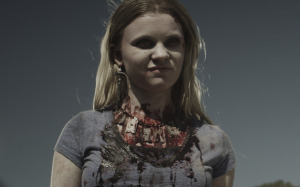
As the body count starts to rise, Kaitlin begins to think that Lincoln is the one killing the bullys; he tells her and Isaac about Moira but, Kaitlin has her doubts until she follows Lincoln back to the basement, where he confronts Moira and begs her to stop. Moira, once again feeling betrayed, tells the boy, “I’m yours Lincoln… and you’re mine.” Now a believer, Kaitlin seeks out Moira and the two bond over a bit of self-loathing and bloodletting, as the vengeful spirit recruits the other to help with the devastation. Now, I know that you guys are pretty sharp, so you’ve probably already guessed a lot about this movie that I didn’t share here, but… I think that there are still enough scares and more than enough buckets of blood to keep you engaged ’til the end. And, if you stick around, there’s a quick tease to let us all know that there will be a sequel. While the underlying current (bullying) is something that the kids should be made aware of, I’m going to suggest that you keep this one away from them until they’re sixteen, at least. The flick is available on DVD or Blu-Ray, as a digital download or Video-On-Demand.
I had the chance to speak to the star of SOME KIND OF HATE, Ronen Rubenstein regarding this movie and another project that will be premiering soon. It’s called CONDEMNED and is in select theaters on November 13. The movie also stars Dylan Penn as a rich kid, squatting with her boyfriend in an abandoned building. Unfortunately, we had horrible reception (he lost signal at least once), which means that I wasn’t able to save enough of our conversation to post the whole thing here. However, he did have this to say about CONDEMNED: “It’s funny, it’s gory; some scenes make you want to throw up, some scenes make you want to laugh.” You had me at “throw up,” Ronen. We’ll definitely be looking for that one soon. Until then, here’s the trailer:

